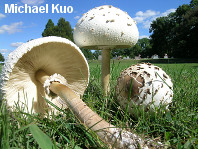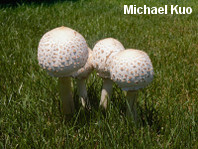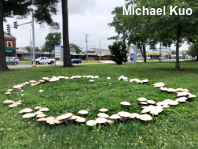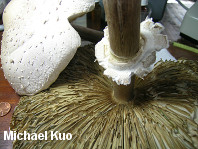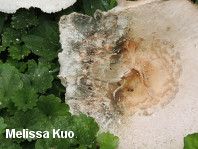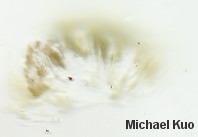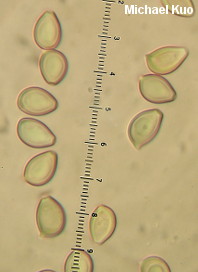| Major Groups > Gilled Mushrooms > Pale-Spored > Lepiotoid Mushrooms > Chlorophyllum molybdites |

|
Chlorophyllum molybdites [ Basidiomycota > Agaricales > Agaricaceae > Chlorophyllum . . . ] by Michael Kuo This beautiful mushroom regularly amazes people by sprouting up in their lawns, often in large fairy rings, in summer and fall. It is easily identified if you have mature specimens in hand, since it has a distinctive greenish spore print and, in old age, greenish gills. If you do not have a mature specimen available, however, you may be hard pressed to reach a confident identification; young specimens have white gills and can be nearly inseparable from the very similar Chlorophyllum rhacodes. In many areas east of the Rocky Mountains, Chlorophyllum molybdites can be confused with Amanita thiersii, which also makes fairy rings and grows in troops in lawns. Close inspection, however, reveals that Amanita thiersii has a shaggy stem to go with its shaggy cap, as well as gills that are white at maturity. Description: Ecology: Saprobic; growing alone, scattered, or gregariously in lawns and meadows—often in troops or fairy rings; summer through fall; widely distributed in North America, but more common from the Great Plains eastward. The illustrated and described collections are from Illinois. Cap: 10–22 cm; convex to spherical when young, becoming broadly convex or nearly flat in age; dry; bald in the button stage, but soon becoming scaly with brown to pinkish brown or tan scales that are uplifted or flat, and concentrated near the center; surface underneath scales finely fibrillose, whitish to pale tan. Gills: Free from the stem or slightly attached to it; crowded; short gills frequent; white when young, becoming grayish green to brownish green as the spores mature. Stem: 8–20 cm long; 1.5–3 cm thick; tapered slightly to apex, and slightly enlarged toward base; dry; bald or very finely fibrillose; firm; white to brownish; discoloring slightly brown on handling; with a persisting, whitish ring that features a greenish to brownish lower edge. Flesh: White throughout; not staining when sliced, or staining reddish brown to pale pinkish red in the base; thick. Odor and Taste: Not distinctive. Chemical Reactions: KOH negative on cap surface. Spore Print: Dull grayish green. Microscopic Features: Spores 9–13 x 6–9 µm; amygdaliform to ellipsoid; smooth; with a slightly truncated end; featuring a small (1 µm) pore; thick-walled; hyaline to faintly greenish in KOH; dextrinoid. Cheilocystidia 40–55 x 10–15 µm; cylindric to subclavate or clavate; thin-walled; smooth; hyaline to brownish in KOH. Pleurocystidia absent. Pileipellis a trichoderm (center of cap, or scales) or cutis (whitish, fibrillose surface). REFERENCES: (G. Meyer, 1818) Massee, 1898. (Saccardo, 1887; Smith, 1949; H. V. Smith, 1954; Sundberg, 1971b; Smith, 1975; Smith, Smith & Weber, 1979; Weber & Smith, 1985; Arora, 1986; States, 1990; Phillips, 1991/2005; Lincoff, 1992; Metzler & Metzler, 1992; Horn, Kay & Abel, 1993; Moreno, Banares & Heykoop, 1995; Vellinga, 2001c; Roody, 2003; Vellinga, 2003c; Miller & Miller, 2006; Kuo, 2007; Vellinga, 2008b; Kuo & Methven, 2014; Evenson, 2015; Siegel & Schwarz, 2016; Woehrel & Light, 2017; Baroni, 2017; Elliott & Stephenson, 2018; Sturgeon, 2018.) Herb. Kuo 08249701, 07220703, 10150701, 06140904, 06101301, 09161401. This site contains no information about the edibility or toxicity of mushrooms. |
© MushroomExpert.Com |
|
Cite this page as: Kuo, M. (2020, January). Chlorophyllum molybdites. Retrieved from the MushroomExpert.Com Web site: http://www.mushroomexpert.com/chlorophyllum_molybdites.html |
